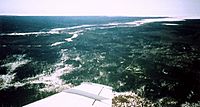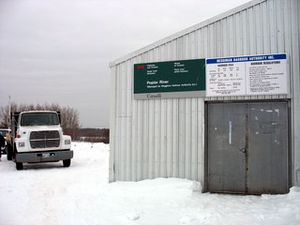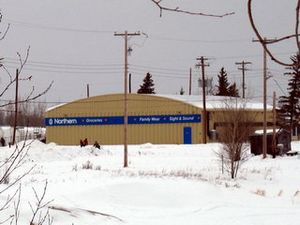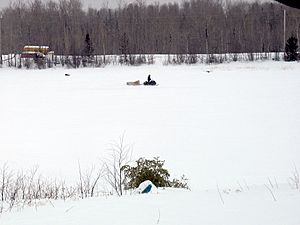Poplar River First Nation facts for kids

Aerial view of Poplar River First Nation looking southwest.
|
|
| People | Ojibwe |
|---|---|
| Treaty | Treaty 5 |
| Province | Manitoba |
| Land | |
| Main reserve | I.R. No. 16 |
| Land area | 15.378 km2 |
| Population (2019) | |
| On reserve | 1,340 |
| Off reserve | 601 |
| Total population | 1,941 |
| Government | |
| Chief | Vera Mitchell |
| Tribal Council | |
| Southeast Resource Development Council | |
The Poplar River First Nation (called Azaadiwi-ziibing in Ojibwe) is a community of Ojibwe people in Manitoba, Canada. It gets its name from the Poplar River, which flows through their land.
Their main land is called Poplar River 16. It is an Indian reserve found on the east side of Lake Winnipeg. The Poplar River flows into the lake right there. The closest big city is Winnipeg, about 400 kilometres (250 miles) to the south.
The Southeast Resource Development Council works with this First Nation. Poplar River is part of Treaty 5, which was signed on September 20, 1875.
Contents
About the Poplar River Community
The Poplar River First Nation covers about 3,800 acres (1,500 hectares). In 2013, there were 1,543 registered members. About 1,245 lived on the reserve, and 298 lived off the reserve.
The main language spoken is Ojibwe. Some people also speak a mix of Cree and Ojibwe, known as Oji-Cree. Many families in the community have surnames like Bruce, Franklin, and Berens.
There are also Métis people and other First Nations people living in the community. There used to be a Métis settlement nearby, but it is no longer there. The community does not have a city or town connected to it.
The people of Poplar River are known for being proud. They are welcoming to everyone, no matter their background. Younger people sometimes call the community "Poplar River #16" or just "#16." This is because of the treaty number, and it has been a nickname for many years.
The two main religions in Poplar River are Roman Catholic and Pentecostal.
Living in Poplar River
The community is built along the main Poplar River. The main part of the community is on a piece of land between the Poplar River and the Franklin River. Most people live along these two rivers. There are also three islands in the Poplar River where people live.
Gravel roads connect all parts of the community. Bridges cross both rivers to link different areas. There are no paved roads or sidewalks.
Today, most people use cars or walk on the gravel roads. But using boats on the water and snowmobiles in winter is still common.
The First Nation calls their traditional land Asatiwisipe Aki. This land has been made a protected area with help from the Manitoba government. It is one of the cleanest river areas left in the world, especially in southern Canada. The river is very clean, with almost no pollution from people. The Poplar River area might soon become a United Nations Heritage Site.
Local Services and Businesses
Northern is the biggest store in Poplar River. It sells many things like food, household items, fuel, electronics, and clothes. It used to be part of the Hudson's Bay Company. Things cost more here than in other parts of Canada. This is because products have to be shipped by plane, boat (in summer), or truck (in winter). They come from far away places like Selkirk or Winnipeg.
Other important places include:
- Mitasosipe Trading Post is the second largest store. It also sells general goods.
- Negginan Harbour Authority Inc. is the main place for small boats to dock. It is managed by Fisheries and Oceans Canada.
- Poplar River Elder's Lodge is a care home for older people in Poplar River.
During winter, you can reach Poplar River by a special winter road. All year round, you can fly there by plane. In summer, you can also travel by boat.
Most homes in the community have modern things like running water, indoor plumbing, and trash collection. However, the community does not have a recycling program.
Children attend Poplar River Elementary School from grade 1 to 9. The school has a modern gym, a library, and regular school programs. If students want to continue their education after grade 9, they go to high schools, colleges, or universities away from the reserve.
Most people in Poplar River have fast internet access. Many homes also have satellite TV for entertainment. Young people in the community enjoy national and international pop culture. This includes music, movies, and fashion trends from all over the world, thanks to satellite TV and the internet.
Natural Environment
The water, land, forests, and beaches in Poplar River are still clean. There is no pollution or industrial activity.
The land is not good for farming. So, growing their own food through farming is not an option. This is because during the last ice age (the Pleistocene period), a huge glacier covered this land. It scraped away the rich topsoil needed for farming. Today, there is only about 10 centimetres (4 inches) of soil over clay. You can see this in summer when clay mud is common in many walking areas.
The community is in the Boreal Forest region of Canada. It does not have permafrost. It is close enough to the North Pole to see the beautiful Northern Lights, also known as the Aurora Borealis.
Health and Well-being
The general health of the community is lower than the national average. Some health challenges, like obesity and diabetes, are more common. These can be linked to genetics, and also to a lack of education about healthy eating and exercise. Heart attacks are also becoming more common for adults around 50 years old. This might be because of fewer healthy food choices brought into the community.
Finding jobs is still a big challenge, which is common for many First Nation communities. This is because there are not enough businesses or new projects to create jobs. Many people rely on social assistance to live. This has been a reality for many families for generations.
Connecting with Traditions
In the past, changes brought by early European settlers and governments caused many problems for Indigenous peoples. Attempts to make Indigenous people change their ways did not work. Losing traditional culture and beliefs has caused feelings of sadness and loss in many communities.
More recently, changes to what people eat might also have negative effects. This is true for all First Nation people, whether they live on or off reserves. New things in food, like extra sugar, salt, and other additives, were not part of their diet for thousands of years. Studies suggest that these changes could affect mental well-being. Not getting enough physical exercise can also lead to sad feelings. There haven't been many deep scientific studies on these specific issues for First Nation peoples.
It has been found that going back to traditional spiritual, cultural, family, and dietary ways of life can make communities healthier. Elders have always fished and hunted, and now this knowledge is being shared with younger generations. Keeping the Ojibwe language alive is also very important. Returning to traditional spiritual healing ceremonies and medicines may help with mental, physical, and emotional health. These teachings are still happening today.
The people in this community continue to work hard to overcome challenges.
Images for kids










